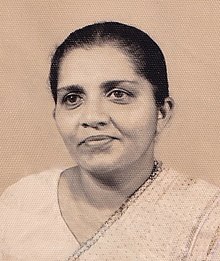Vivienne Goonewardene | |
|---|---|
 Goonewardene in 1961 | |
| Secretary of Home Affairs | |
| In office 1964–1965 | |
| Junior Minister of Health | |
| In office 1970–1977 | |
| Member of the Ceylonese Parliament for Dehiwala-Mount Lavinia | |
| In office 1970–1977 | |
| Preceded by | S. de Silva Jayasinghe |
| Succeeded by | S. de Silva Jayasinghe |
| Majority | 51.63% |
| Member of the Ceylonese Parliament for Borella Electoral District | |
| In office 1964–1965 | |
| Preceded by | W. Danister de Silva |
| Succeeded by | M. H. Mohamed |
| Majority | 47.96% |
| Member of the Ceylonese Parliament for Colombo North Electoral District | |
| In office 1956–1960 | |
| Preceded by | Cyril E. S. Perera |
| Succeeded by | V. A. Sugathadasa |
| Majority | 58.09% |
| Personal details | |
| Born | Violet Vivienne Goonetilleke 18 September 1916 Ceylon |
| Died | 10 March 1996 (aged 79) Colombo, Sri Lanka |
| Political party | Lanka Sama Samaja Party |
| Other political affiliations | Bolshevik–Leninist Party of India, Ceylon and Burma |
| Spouse | |
| Relations | Philip Gunawardena, Robert Gunawardena |
| Children |
|
| Alma mater | Musaeus College University College, Colombo |
| Occupation |
|
Violet Vivienne Goonewardene[Notes 1] (Sinhala: වයලට් විවියන් ගුණවර්ධන, Tamil: வயலட் விவியென் கூனவர்தன; 18 September 1916 – 3 October 1996), commonly known as "Vivi", was a Sri Lankan anti-colonial activist and prominent politician, serving as one of the world's first female ministers. A key figure in both the Indian independence movement and the Sri Lankan independence movement, Goonewardene was a prominent member on the non-aligned stage, where she fought against perceived injustices and was critical of the Middle East diplomacy sponsored by the United States. Goonewardene was the first and, to date, only female National Hero of Sri Lanka. By her death, she was one of the Left's most vibrant personalities, and the foremost female figure in the Sri Lankan leftist movement.[2]
Born into an affluent family to a pro-monarchy conservative, while at secondary school, Goonewardene became involved in the anti-imperialist Suriya-Mal Movement, fighting against perceived injustices. She volunteered during the 1934 Malaria Epidemic, at which time she witnessed rampant malnutrition of the poor. Despite being disallowed by her father from pursuing higher education, her maternal uncles, Philip and Robert Gunawardena, helped her attend University, where she was often involved in activism. It was here that she met her husband, Leslie Goonewardene, who had founded in 1935 Sri Lanka's first political party, the Lanka Sama Samaja Party.
During her political career, she was instrumental in the rise of the Lanka Sama Samaja Party. With the beginning of the Second World War, Goonewardene evaded arrest by fleeing to India under a false name. There, she immersed herself in the Quit India Movement, culminating in India's independence from Britain in 1947. Upon her return to Sri Lanka, she played a large role in Sri Lanka's independence from Britain in 1948. From the 1940s to 1960s, the Lanka Sama Samaja Party was Sri Lanka's main opposition party and in the 1960s, the party led the United Front coalition; through their election landslide bringing in the first female Prime Minister. Goonewardene served as a prominent member of Parliament, and as President of the All Ceylon Local Government Worker's Union from 1949 until her death. Through this, Goonewardene attempted to reform the former British colony of Ceylon into a socialist republic by nationalising organisations in the banking, education, industry, media, and trade sectors.
- ^ Ervin 2006, pp. 95, 102, 128, 189.
- ^ "An indelible mark of left politics". Silumina. 30 October 2020. Retrieved 12 June 2021.
Cite error: There are <ref group=Notes> tags on this page, but the references will not show without a {{reflist|group=Notes}} template (see the help page).